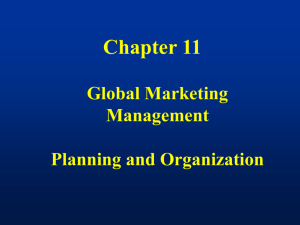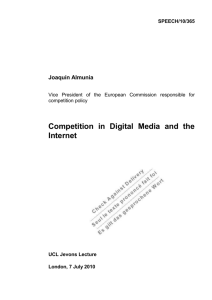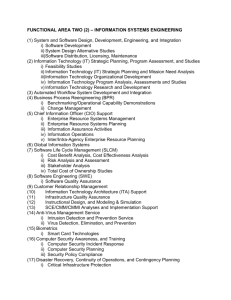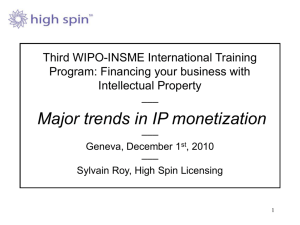Licensing, Franchising and Merchandising
advertisement
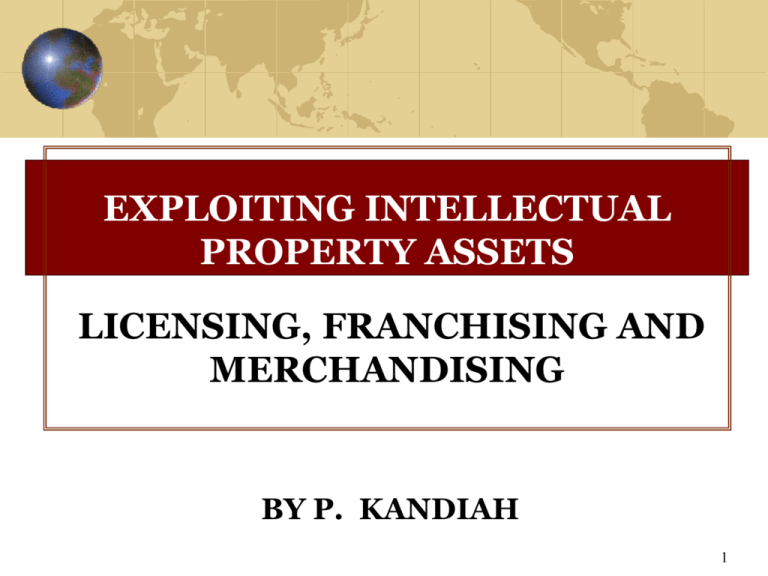
EXPLOITING INTELLECTUAL PROPERTY ASSETS LICENSING, FRANCHISING AND MERCHANDISING BY P. KANDIAH 1 “THE EMPIRES OF THE FUTURE ARE THE EMPIRES OF THE MIND” 2 In the globalized and integrated world more use is made of IP internationally. Global expansion in use of IP Patents, Trade Marks, Industrial Designs filed in several countries. Various ways devised to increase income. 3 Extension of market territories 4 Extension of product range. Cigarettes Dunhill Perfume Watches 5 Extension of product range (Cont’d). Nike Sports Shoes Soccer Ball Golf Balls T-Shirt 6 Sub-division of product manufacturing and marketing Eg. Nike shoes. R&D and Design Manufacturing Marketing creation, – USA (high value activity) – Indonesia, Vietnam, Malaysia (low value activity) – Control from US – Sales – whole world (strategic control) 7 Out Licensing In 8 Licensing Out Ownership and Control of IP Licence given to 3rd parties to use IP under specific terms Royalty income 3rd party can be a joint-venture Extension of Brand, Product range, market etc. 9 Licensing Out (Cont) Ensure ownership of IP Ensure control of IP Clear contracts / agreements Right to check use of IP • Inspect premises • Inspect sales and account records If joint-venture ensure proper shareholder agreements. 10 Licensing In Use of third party IP Rights To extend business / new business Precaution to take Determine whether IP Licence required Conduct IP due diligence Differentiate between licensing agreement and distributorship agreement Is there risk taking by licensor? Who owns IP Rights in distributorship channels. Royalty rates / payment must be strategically structured. Government approval of royalty rates Tie – in clauses – valid? 11 Franchising Establish business model in one place Attempt to replicate success in another location by third party by Agreement. Extension Use of IP Rights. Regulated by specific laws in many countries. 12 Examples of successful franchises 1. McDonalds 2. KFC 3. KPMG 4. PWC 13 Examples of successful franchises (Cont’d) 5. Starbucks 6. Dunkin Doughnuts 7. Saravanna Bhavan 8. Anjappar 14 Franchisor owns IP Rights in Trademark / Brand. Operating procedures. Patents on equipment used in business. Owns Copyright / Patents in software systems. Marketing knowledge. 15 Franchising includes payment of upfront fees (usually nonrefundable). payment of royalty fees (based on total turnover). training of franchisee (staff) provision of operating manual. access to specialty equipment. 16 Franchising In developing countries quick way to learn established business models, management methods, quality control, etc. 17 Case study in Malaysia 1. Secret Recipe 2. Old Town Coffee 3. Mary Brown Chicken 18 Merchandising Extension of branding to non-core products. Build-up product recognition. Distinctive trademark packaging Method of sales / point of sales Ownership of all IP Rights. 19 Distribution Agreement. Sales Agreement – one-off / long-term Agreement. Agency Agreements (principal / agency relationship). Consignment Agreements. Contract manufacturing for 3rd parties. 20 Conclusion Developing countries are net receivers of IP Rights. Very little local IP Creation. Challenge How to take advantage of patents, industrial designs, copyright, knowhow that are in the public domain in Bhutan 21 Taking expired 3rd party IP Rights Unprotected 3rd party IP Rights in Bhutan • Is not legally wrong. • Is it morally wrong? Non-protection in Bhutan is an express indication that owner of IP Rights has “donated” his IP Rights to Bhutan! 22 THANK YOU P. Kandiah Tel: +603 2284 7872 Fax: +603 2284 1125 E-mail: ipr@kass.com.my 23


